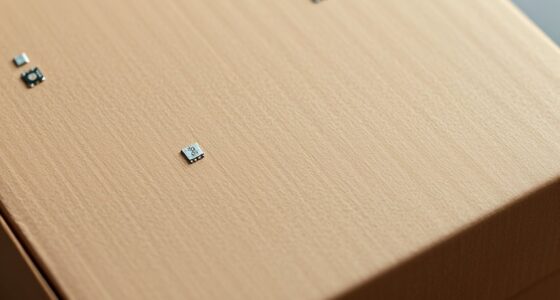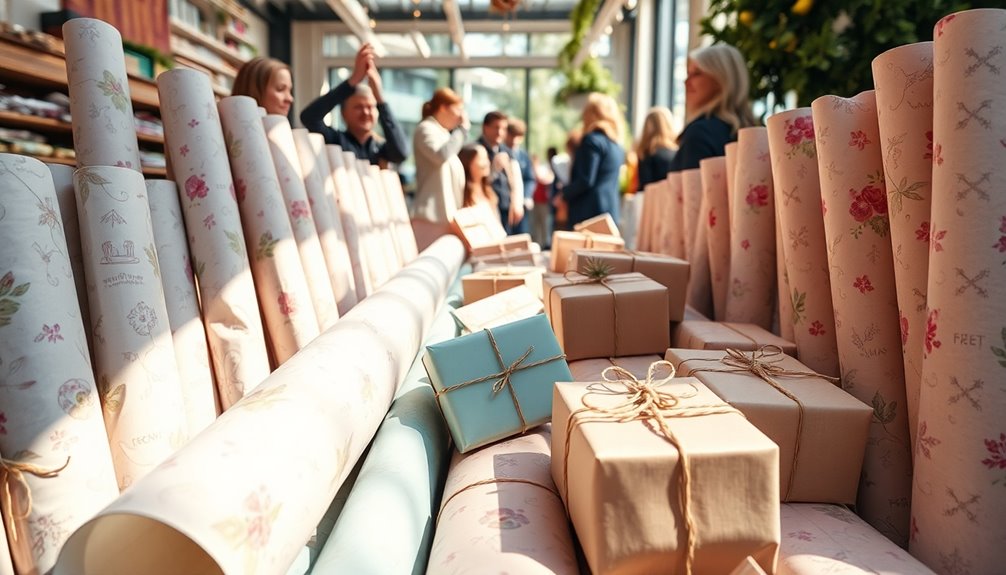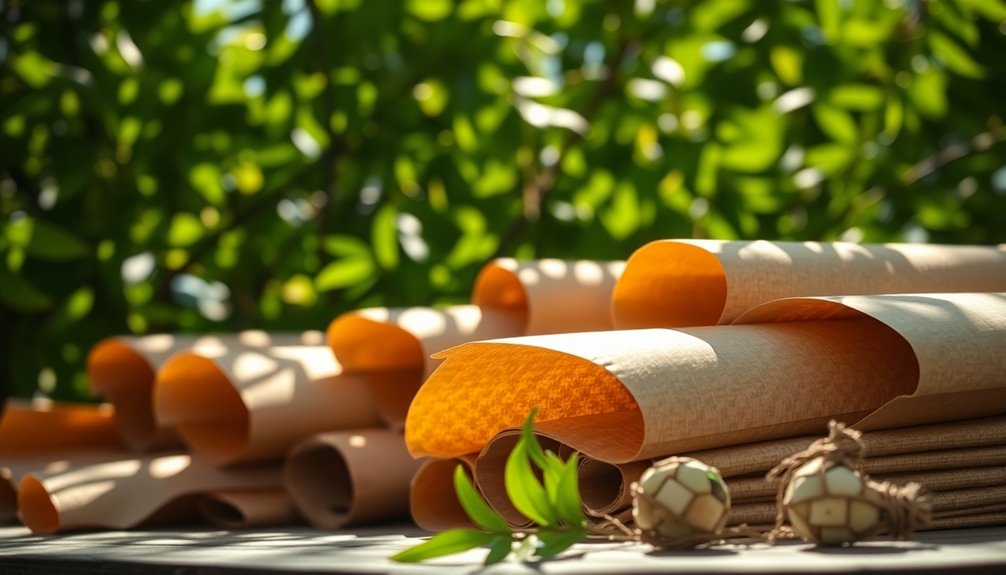To find sustainable gift wrap alternatives beyond traditional paper, consider using reusable fabric wraps or furoshiki techniques that can be used repeatedly. You can also upcycle materials like old maps, magazine pages, or fabric scraps to create unique, eco-friendly wraps. Natural elements such as dried flowers or seed pods add a charming touch. Exploring biodegradable and plant-based options, alongside minimalist and zero-waste ideas, can help you wrap gifts more sustainably—your journey to greener gifting starts here.
Key Takeaways
- Use fabric wraps with Furoshiki techniques for reusable, eco-friendly gift presentation rooted in Japanese tradition.
- Incorporate upcycled materials like maps, magazine pages, or old book pages for creative, biodegradable gift wrapping options.
- Opt for plant-based, biodegradable wrapping materials and natural dyes to ensure eco-conscious, compostable packaging.
- Enhance wraps with botanical elements such as dried flowers, seed pods, or natural twine for sustainable decorative accents.
- Choose eco-friendly, recycled kraft paper or unbleached kraft as simple, versatile alternatives to traditional wrapping paper.
Reusable Fabric Wraps and Furoshiki Techniques

Reusable fabric wraps and furoshiki techniques offer stylish and eco-friendly alternatives to traditional gift wrap. Unlike traditional wrapping techniques that often rely on single-use paper, furoshiki involves beautifully fabric-based wrapping methods rooted in Japanese culture. The cultural significance of furoshiki emphasizes respect for the environment and thoughtful presentation, making it more than just a wrapping style. You can choose vibrant, durable fabrics that can be reused countless times, reducing waste. Mastering furoshiki allows you to wrap gifts creatively while honoring tradition. These techniques aren’t only practical but also add a personal touch to your presents. Embracing fabric wraps helps you make sustainable choices, turning gift-giving into an opportunity to celebrate culture and environmental consciousness simultaneously. Additionally, reusable fabric wraps generate less pollution compared to disposable paper, supporting a cleaner planet. Incorporating these methods can enhance your appreciation for cultural traditions and promote eco-friendly habits in everyday life. Using natural materials like organic cotton or hemp further enhances the sustainability of your wrapping approach.
Upcycled and Recycled Materials for Gift Wraps

You can choose eco-friendly papers made from recycled fibers or plant-based materials to reduce waste. Repurposing items like maps, old book pages, or magazine covers adds a creative touch while giving materials a second life. These ideas not only save resources but also make your gift wrapping uniquely personal. Incorporating sustainable packaging options further enhances your eco-conscious approach to gift wrapping. Additionally, selecting materials with recyclable qualities ensures your wrapping remains environmentally friendly after use. Choosing materials with biodegradable features can also help minimize environmental impact after disposal, especially when combined with compostable design practices.
Eco-Friendly Paper Choices
Choosing eco-friendly paper options for gift wrapping means prioritizing upcycled and recycled materials that reduce waste and conserve resources. Instead of relying on traditional gift wrap, opt for recycled kraft paper or upcycled fabric wraps that can be reused. Decorative tissue paper made from recycled fibers adds a colorful touch without the environmental impact of new paper production. These options help you avoid single-use, non-biodegradable wrapping paper, lowering your carbon footprint. Look for products labeled as recycled or upcycled, ensuring they’re made from post-consumer waste. By choosing these materials, you not only protect the environment but also add a unique, textured look to your gifts. Understanding the importance of proper maintenance and cleaning techniques can help ensure the longevity of reusable wrapping materials, making your sustainable gifting efforts even more effective. Incorporating material durability considerations when selecting wrapping options can further extend their usability and lifespan. Proper storage methods are essential for preserving the quality of your reusable materials and preventing damage over time. Additionally, being aware of material identification can assist in selecting the most suitable materials for reuse and recycling. Eco-friendly paper choices prove that sustainable wrapping can be both stylish and responsible. Additionally, selecting appropriate storage methods can help preserve the quality of your reusable materials for multiple uses over time.
Repurposed Material Ideas
Have you considered transforming everyday items into beautiful gift wraps? Upcycled and recycled materials breathe new life into traditional gift wrapping, aligning with seasonal wrapping trends that favor sustainability. Instead of tossing old newspapers or fabric scraps, you can create charming wraps that tell a story. For example, use colorful magazine pages, vintage scarves, or cardboard boxes decorated with natural elements. Here’s a quick visual:
| Material | Style Inspiration | Best Use |
|---|---|---|
| Old Maps | Travel-themed wraps | For adventure lovers |
| Reclaimed Fabric | Vintage charm | For eco-conscious gifting |
| Brown Paper | Rustic elegance | For seasonal or rustic gifts |
Incorporating environmentally friendly materials can further elevate your handmade wraps, making them both attractive and sustainable. These ideas give your gifts a unique touch while reducing waste, making your wrapping both eco-friendly and trendy. Incorporating quality materials can enhance the durability and aesthetic appeal of your handmade wraps.
Plant-Based and Biodegradable Wrapping Options
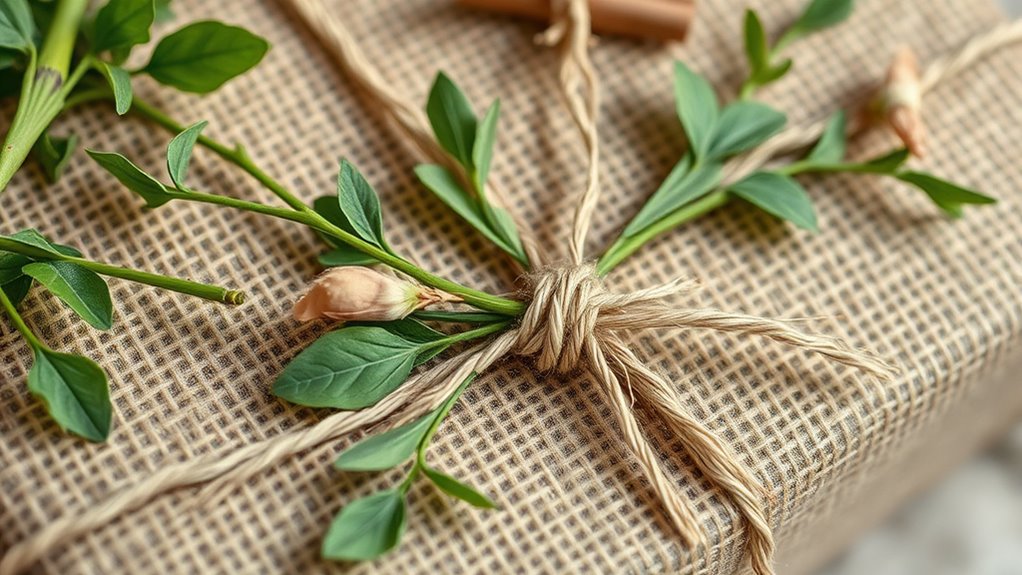
Plant-based and biodegradable wrapping options offer eco-friendly benefits, as they break down naturally and reduce waste. Using compostable materials can make your gifts more sustainable, while plant-based inks guarantee the entire wrapping process remains environmentally gentle. These choices help you give thoughtfully without harming the planet. Additionally, selecting spoiled lemon juice or fruit residues for natural dyes can further enhance eco-conscious gift wrapping. Incorporating biodegradable adhesives can also ensure the entire wrapping process remains environmentally friendly and compostable. Implementing sustainable business practices in packaging can further minimize environmental impact and promote eco-awareness. Regularly reviewing regulatory compliance in eco-friendly packaging ensures your practices align with current environmental standards. Moreover, choosing juice residues from healthy beverage brands can inspire creative and sustainable decorating ideas for your wraps.
Compostable Material Benefits
Because they break down naturally without leaving harmful residues, compostable materials like plant-based and biodegradable wraps provide an eco-friendly alternative to traditional gift wrap. These options help reduce landfill waste and lower your environmental impact. Many biodegradable wraps feature biodegradable coatings that enhance durability while maintaining their compostability. When you use these materials, it’s important to follow proper composting guidelines to ensure complete breakdown. This includes removing any non-compostable elements, such as metallic finishes or plastic closures, before composting. By choosing compostable wraps, you support sustainable waste management practices and contribute to a healthier planet. Their ability to decompose safely makes them an excellent choice for environmentally conscious gift-giving. Additionally, understanding payment processing security measures can help ensure responsible consumption of online resources related to eco-friendly products.
Plant-Based Ink Options
Using plant-based ink options for wrapping adds an eco-friendly touch to your gift-giving. These inks are made from natural ingredients like soy, vegetable oils, or algae, reducing harmful emissions. When choosing biodegradable wrapping, consider the ink formulations that suit your printing techniques.
Here’s how plant-based inks enhance your wrapping:
- They are compatible with various printing techniques, ensuring vibrant, crisp designs without synthetic chemicals.
- Their natural origins mean they break down easily, minimizing environmental impact.
- They offer versatility for custom printing, from simple stamps to detailed illustrations.
Eco-Friendly Kraft Paper and Brown Paper Alternatives
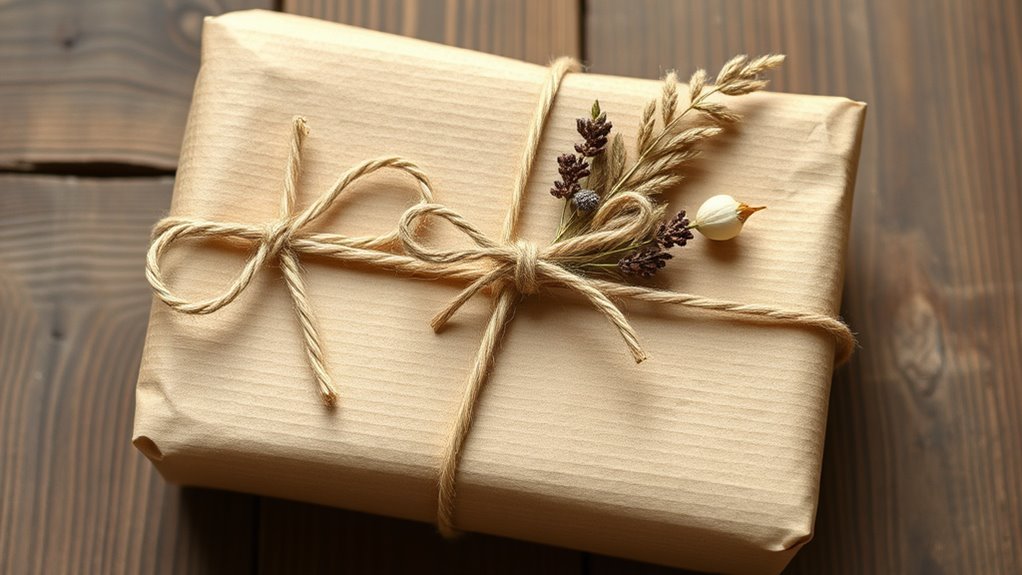
Eco-friendly kraft paper and brown paper alternatives offer a sustainable choice for gift wrapping that minimizes environmental impact. Their natural, unbleached appearance makes them versatile for various gift wrap design styles, from rustic to modern. You can easily personalize kraft paper with stamps, drawings, or ribbons, creating a unique look that suits any occasion. These papers also honor cultural wrapping traditions, such as Japanese Furoshiki or traditional paper wrapping methods, by emphasizing simplicity and resourcefulness. Choosing kraft or brown paper reduces waste and avoids the use of glossy coatings or synthetic inks. Plus, their durability allows for reuse, making your gift presentation both eco-conscious and stylish. Incorporating these alternatives supports a more sustainable, culturally respectful approach to gift wrapping. Additionally, selecting high-quality kraft paper can also ensure trustworthiness of the product, aligning with environmentally conscious values.
Natural Elements and Botanical Embellishments
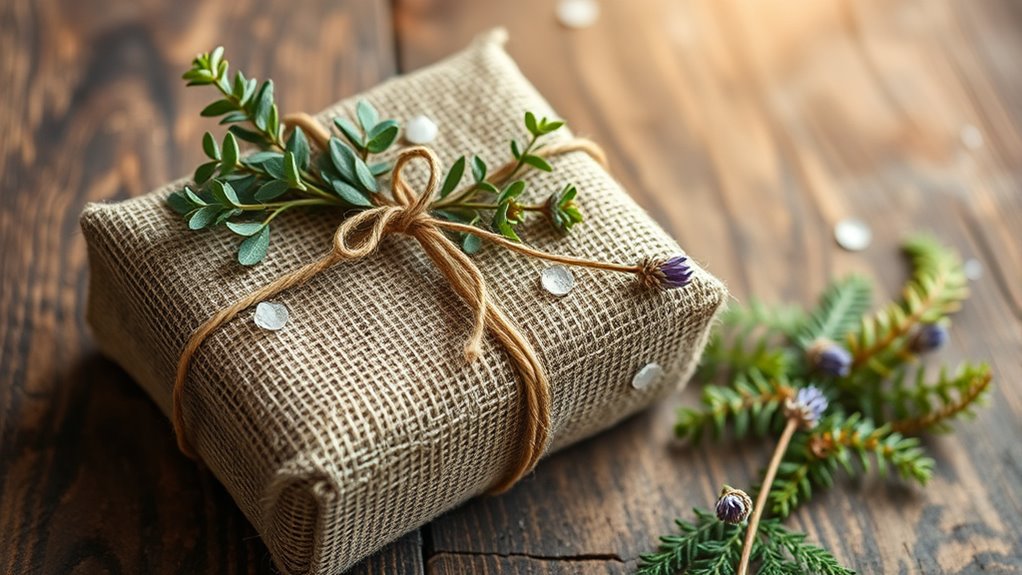
Incorporating natural elements and botanical embellishments into your gift wrapping adds a charming, eco-conscious touch that enhances its overall appeal. You can elevate simple wrapping by attaching:
- Ornamental seed pods, which add texture and a natural, rustic look.
- Dried flower arrangements, providing color and a delicate feel.
- Twine or jute string, to secure and complement these botanical accents.
These elements are sustainable and biodegradable, making your gift stand out while respecting the environment. Ornamental seed pods can be glued or tied onto the package, while dried flowers add a soft, elegant touch. Jute string or twine wraps everything together, giving your wrapping a polished yet earthy finish. It’s a simple way to personalize your gifts sustainably.
DIY Reusable Gift Bags and Containers
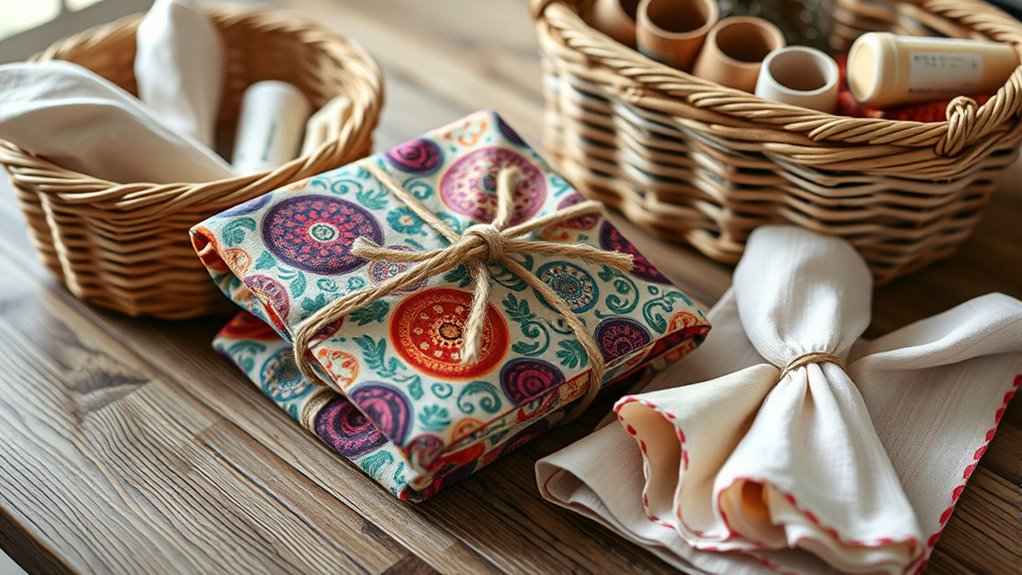
Transforming your gift presentation with DIY reusable bags and containers is an effective way to extend sustainability beyond wrapping materials. You can choose fabrics like cotton, linen, or upcycled textiles to create personalized gift bags that reflect your style. When designing your gift bag, consider simple, sturdy gift bag design techniques that make reuse easy. This approach also aligns with wrapping etiquette, showing thoughtfulness while reducing waste. You might add decorative elements such as ribbons or embroidery for a special touch, but keep in mind that minimal embellishments often make reusing simpler. By crafting your own reusable containers, you not only cut down on disposable waste but also add a meaningful, eco-friendly element to your gift-giving tradition.
Creative Wrapping With Newspapers and Magazines
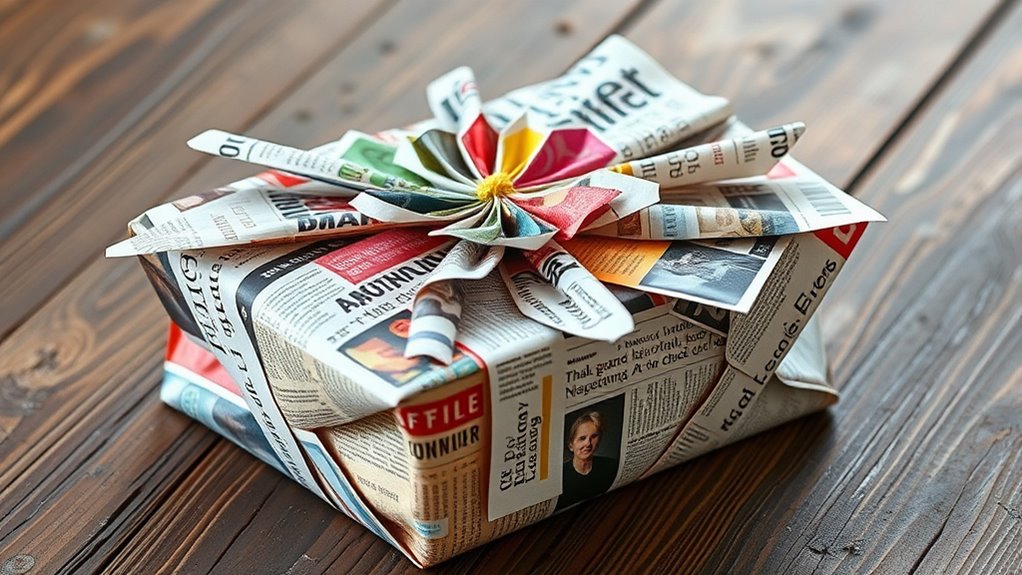
Using newspapers and magazines as wrapping materials offers a creative way to repurpose materials you already have while adding a unique, personalized touch to your gifts. Don’t fall for recycling myths that suggest these materials are unsuitable; they’re perfectly fine if you follow proper wrapping etiquette—like removing any ads or sensitive content. Here are some ideas to get started:
- Use colorful magazine pages for vibrant, eye-catching wraps that stand out.
- Incorporate playful text or images for a fun, eclectic look.
- Reinforce with natural twine or ribbon for a polished finish.
This approach not only reduces waste but also adds character to your gifts. Just remember to keep it neat and avoid covering important details, balancing creativity with practicality.
Minimalist and Zero-Waste Wrapping Ideas
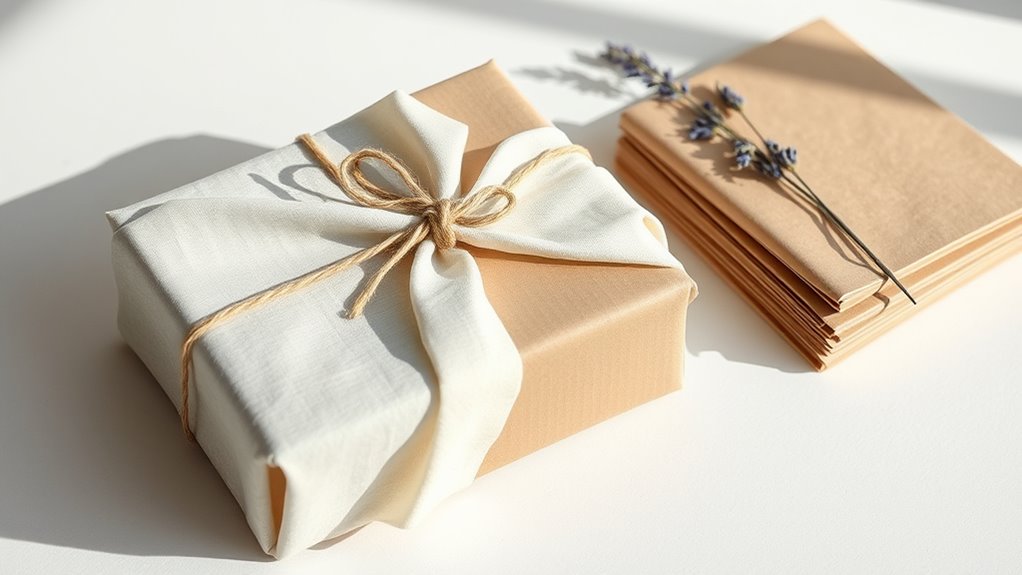
Building on the creative ways to repurpose materials like newspapers and magazines, minimalist and zero-waste wrapping ideas focus on simplicity and reducing waste. You can embrace minimalist aesthetics by using plain fabric, burlap, or cloth bags that serve as both gift wrap and keepsakes. These options promote zero waste practices, as they’re reusable and eco-friendly. Additionally, consider tying gifts with natural twine, raffia, or reusable ribbon instead of single-use tape. Here’s a quick comparison:
| Material | Benefits |
|---|---|
| Fabric Wraps | Reusable, stylish, minimalist aesthetic |
| Recycled Paper | Eco-friendly, versatile, zero waste |
| Cloth Bags | Practical, durable, zero waste |
These ideas help you reduce waste while maintaining elegant, minimalist presentation.
Frequently Asked Questions
How Can I Ensure Reusable Wraps Are Hygienic for Multiple Uses?
To keep reusable wraps hygienic for multiple uses, you should practice proper sanitation. After each use, clean the wraps with mild soap and water or follow any specific care instructions. Store them in a hygienic manner, such as in a clean, dry container or designated storage space. Regularly inspect for signs of wear or mold. Implementing good hygiene and sanitation practices guarantees your reusable wraps stay fresh and safe for future gifting.
Are There Specific Plants Best Suited for Biodegradable Wrapping Materials?
You ask about specific plants best suited for biodegradable wrapping materials. For plant suitability, consider plants like hemp, jute, and bamboo, which produce strong biodegradable fiber options. These plants grow quickly, require fewer resources, and break down naturally, making them excellent for eco-friendly wrapping. By choosing such plants, you guarantee your gift wrap is both sustainable and effective, reducing environmental impact while maintaining durability.
What Are Some Cost-Effective Alternatives to Traditional Gift Wrap?
Did you know that Americans use about 4.6 million tons of wrapping paper annually? To save money and reduce waste, consider recyclable fabrics like old scarves or t-shirts for DIY wrapping ideas. These options are affordable, eco-friendly, and add a personal touch to your gifts. Using reusable materials not only cuts costs but also minimizes environmental impact, making your gift-giving more sustainable and stylish.
How Can I Personalize Eco-Friendly Wraps for Special Occasions?
You can personalize eco-friendly wraps by adding custom stamping to create unique patterns that match the occasion. Use fabric embellishments like ribbons, buttons, or embroidered patches to give your wraps a special touch. These options make your gift wrapping more meaningful and eco-conscious while showcasing your creativity. Plus, reusable fabric wraps with personalized details make a lasting impression, making your gifts memorable and sustainable.
Can Sustainable Wrapping Methods Be Suitable for Commercial Gift Packaging?
Think of sustainable wrapping as planting seeds for a greener future; it’s more than just a trend. For commercial gift packaging, using decorative fabrics and recyclable inks can be a game-changer. These methods are durable, visually appealing, and eco-friendly, proving that sustainability and professionalism can coexist beautifully. You can make your brand stand out while protecting the planet—showing that caring for the environment is part of your business’s true essence.
Conclusion
By choosing sustainable gift wrap alternatives, you’re transforming your presents into a canvas of kindness that blooms beyond the usual paper. Think of each eco-friendly wrap as a whisper of nature’s beauty, wrapping your gifts in a dance of creativity and care. With every mindful choice, you’re planting seeds of change, turning ordinary wrapping into an extraordinary act of love for the planet. Let your gifts tell a story that’s both beautiful and kind to Earth.


